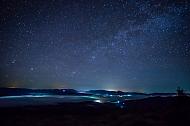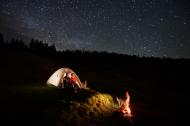Winter Celestial Calendar
Exploring the Night Sky
The Haliburton Highlands’ naturally dark skies create the perfect backdrop for exploring the cosmos. Whether you’re a seasoned astronomer or a casual stargazer, the peaceful surroundings offer a rare chance to experience the universe’s wonders. In this designated Dark Sky area, you’ll uncover a connection to the stars that is as timeless as it is awe-inspiring.
Did you know? The best time for stargazing is during New Moons when the absence of moonlight reveals the sky’s full brilliance.
Important Celestial Dates
Whether you’re marveling at meteors showers or catching a glimpse of Mercury at its farthest point from the Sun, the sky above the Highlands becomes a canvas of wonder and discovery. These key celestial events are perfect moments to step outside, look up, and let the universe take your breath away.
 Dec 13/14: Geminid Meteors
Dec 13/14: Geminid Meteors
The Geminids peak around the night of December 13–14, depending on your time zone. It is usually one of the best meteor showers of the year.
 Dec 20: New Moon
Dec 20: New Moon
The final New Moon of 2025 falls at 01:43 UTC. A New Moon occurs when the Moon passes between Earth and the Sun—it is sometimes referred to as the invisible phase.
 Dec 21: December Solstice
Dec 21: December Solstice
The December solstice takes place at 15:03 UTC. In the Northern Hemisphere, this is the winter solstice and the shortest day of the year. Meanwhile in the Southern Hemisphere, it is the summer solstice and the longest day of the year.
 Dec 21/22: Ursid Meteors
Dec 21/22: Ursid Meteors
Once again, the astronomical year rounds off with the Ursid meteor shower, which usually peaks around this date.
 Jan 3: Wolf Moon
Jan 3: Wolf Moon
The first Full Moon of the year is colloquially known as the Wolf Moon in many northern cultures.
Traditional Full Moon names Mnidoo-Giizis – Recognition of the Moon
 Jan 3: Earth at Perihelion
Jan 3: Earth at Perihelion
At around 17:15 UTC, the Earth reaches perihelion—the point on its orbit closest to the Sun.
Jan 3/4: Quadrantid Meteor Shower
The first major meteor shower of 2026, the Quadrantids, peaks on the night of January 3 and the early morning hours of January 4 (depending on your time zone).
 Jan 10: Jupiter at Opposition
Jan 10: Jupiter at Opposition
The massive planet, Jupiter, reaches the opposite side of Earth to the Sun, and is visible from sunset to sunrise.
 Jan 18: New Moon
Jan 18: New Moon
A New Moon in the sky means no moonlight to hinder your view of stars and planets. Use our Interactive Night Sky Map to find out what planets are visible tonight and where.
 Feb 1: Snow Moon
Feb 1: Snow Moon
February’s Full Moon is also known as the Snow Moon in many Northern Hemisphere cultures.
Mkwa-Giizis – Recognition of the Moon
 Feb 17: New Moon
Feb 17: New Moon
Take advantage of the New Moon to check out the skies with our Interactive Night Sky Map, weather permitting, of course.
 Feb 19: Mercury at Greatest Elongation East
Feb 19: Mercury at Greatest Elongation East
This might be a good time to try and spot Mercury: The planet appears at its farthest distance from the Sun in the evening sky.
Find Mercury with our Interactive Night Sky Map
 Mar 2/3: Total Lunar Eclipse
Mar 2/3: Total Lunar Eclipse
This is the last total lunar eclipse until the very end of 2028. Totality will be visible across parts of North and South America, Australia, and Asia.
 Mar 3: Worm Moon
Mar 3: Worm Moon
The Full Moon in March is traditionally called the Worm Moon, after earthworms that tend to appear around this time in many locations in the Northern Hemisphere.
Ziisbaakdoke-Giizis – Recognition of the Moon
 Mar 19: New Moon
Mar 19: New Moon
Dark nights a few days before and after the Moon reaches its New Moon phase at 01:23 UTC on March 19 are the best nights to do some night sky watching—see our map!
 Mar 20: March Equinox
Mar 20: March Equinox
The March equinox is the first day of spring in the Northern Hemisphere and the start of fall in the Southern Hemisphere, by astronomical definitions.
Haliburton Forest’s Astronomy Program
Nestled deep within the Haliburton Highlands, the Haliburton Forest and Wild Life Reserve is a haven for astronomy enthusiasts. With minimal light pollution, it offers some of the most breathtaking views of the night sky.
Plan Your Visit:
- Join their Astronomy Program in July and August for a guided stargazing experience.
- Stay overnight during winter to witness the pristine beauty of the celestial panorama.

Viewing Conditions
Stay prepared for your stargazing adventure by checking the viewing conditions ahead of time. Whether you’re planning to catch a meteor shower or simply enjoy the constellations, knowing the weather and sky clarity ensures a magical night.
